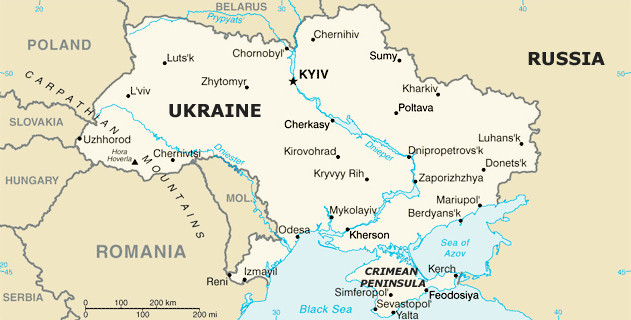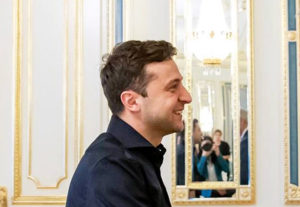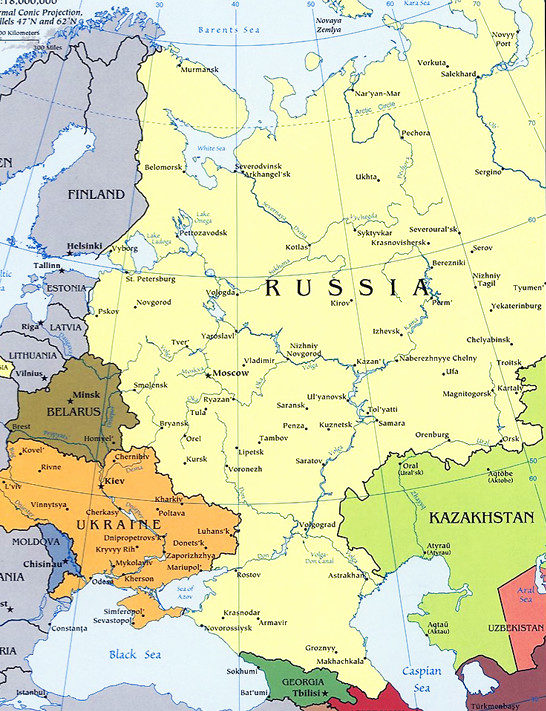New Russian Policy Toward Ukraine: Citizenship Beyond the Borders

(Kennan Institute – wilsoncenter.org/program/kennan-institute – Kennan Cable No. 54 – Igor Zevelev, Global Fellow; Former Professor at George Marshall European Center for Security Studies; Former Director, MacArthur Foundation, Moscow Office – July 9, 2020)
A major change in Russian policy towards Ukraine is underway. Policymakers, experts, and the media across the world have focused mostly on the conflict in eastern Ukraine. This is understandable: around 14,000 people have died in the war, and prospects for peace are dim. At the same time, many essential developments in the relationship go under the radar. Russia’s new policy of offering citizenship to millions of Ukrainians is perhaps the most important example. Proliferation of Russian passports in Ukraine has accelerated in recent years and will have long-term demographic, economic, social, and political consequences. New amendments to the Russian citizenship law adopted in the last year may have a far-reaching impact-not only on Ukraine, but also on the security architecture in Eastern Europe and across the entire post-Soviet space.
What is Ukraine to Russia?
Ukraine is the most important country among the Soviet successor states (and probably in the entire world) for Russia’s national security and national identity. In spite of, and probably because of, this fact, the relationship between the two countries has been extremely difficult after the Soviet collapse.
In late February 2020, President Vladimir Putin once again shared his interpretation of Ukrainian history in an interview with Russia’s major state news agency, TASS. The key to his understanding of Russian and Ukrainian national identities is an unshakable belief “that we are one and the same people.”[1]This concept has guided Putin’s Ukraine policy for 20 years. It is deeply rooted in Russian intellectual history and discourse and demonstrates the surprisingly strong impact that ideas generated in the 19th century have on the Kremlin’s worldview and its foreign policy thinking today.
British historian Geoffrey Hosking wrote that “Britain had an empire, but Russia was an empire – and perhaps still is.”[2] As a result, there have been no clear and historically consistent criteria for distinguishing “us” from “them” in Russian consciousness. The Russian intellectual elite of the 19th century usually lagged behind conceptual changes happening among other peoples of the empire. While non-Russians in the Western parts of the empire were busily constructing collective mental boundaries between themselves and Russians in the second half of the 19th century, this process often went unnoticed in St. Petersburg and Moscow.
Among Russians, there was a lot of disagreement between the Slavophiles and Westerners; between the author of “official nationalism” Sergei Uvarov and Christian mystic Vladimir Solovyov; between conservative imperialist Nikolay Danilevsky and “universalist” Fyodor Dostoyevsky. What united all of them was their focus on Russia’s relation to Europe as a whole, and lack of interest in other peoples within the empire. In the minds of most Russian intellectuals of that time, the “Little Russians” (Ukrainians), the “White Russians” (Belarusians), and the “Great Russians” (ethnic Russians) comprised one Russian people, while all others (inorodtsy) were practically excluded from their theoretical discourse.[3] This intellectual tradition outlived the empire, and continued to drive both Soviet and post-Soviet Russian narratives.
In 1991, it wasn’t just the Soviet Union that collapsed, but a centuries-old Russian empire that disappeared from the political map overnight. However, that empire did not disappear from the mental maps of many people in Russia. Russians had a difficult time recognizing the newly independent neighboring states, Ukraine and Belarus in particular, as separate nations. This prompted a deep national identity crisis in 1991, and it lingers to this day. One serious consequence of this crisis is the ambiguous set of ideas about Ukraine in the Russian national discourse.
Today, Russians view Ukraine in many different ways. It is considered a neighboring independent state, an emerging European country, a culturally close Slavic country, a part of a historic Russia, a potential member of a hostile military alliance (NATO), and a state that continues to hold (illegally) certain pieces of land that belong to Russia. All of these conflicting images and visions coexist in the public and political discourses-and politicians, policymakers, and public intellectuals employ many of them simultaneously. Abstract conceptions and historic images make their way to concrete policymaking in Russia with remarkable ease.
Politics of national identity and citizenship
In most countries, politics, as well as bureaucratic politics, are essential processes that connect abstract thinking about national identity with foreign policy.[4] In Russia, there are important internal intellectual and political divisions within the elite over the essence of Russian statehood and nationhood. The multi-layered and contested political and intellectual environment explains why Moscow’s actions toward Ukraine are often inconsistent and hard to predict: the perception of Ukraine is intimately related to Russian national identity, an identity that is still being formed. Policy outcomes in Russia rarely result from open political struggle. Instead, there is a bargaining game behind closed doors among a relatively small and tight-knit group of governmental actors.
The internal bureaucratic fight over whether to grant Russian citizenship to millions of Ukrainians originated in the mid-1990s and simmered until 2017, when a gradual process of easing naturalization procedures for Ukrainians started. This process accelerated in 2020. Both the long battle and recent seminal decisions over the citizenship policy reflect the coexistence of different visions of Russia and Ukraine within the Russian elite.
Prior to 2018, Russia’s citizenship law, repatriation program, and migration policies did not distinguish between ethnic Russians, Russian-speakers, Eastern Slavs, and other groups. For Russian ethnic nationalists, this policy looked inconsistent and even absurd. Mikhail Remizov, a prominent author and political strategist, lamented: “[ethnic] Russian diasporas do not receive any targeted support from the Russian Federation and Russian repatriates do not have any privileges when applying for citizenship.”[5] Some Russian ethnic nationalists included Russian-speaking Ukrainians into their conception of “Russians.”
Influential groups within the Russian elite shared these ethnic nationalist sentiments for pragmatic reasons. The so-called economic bloc in the executive branch, as well as many liberal economists, leaned toward easing migration rules. They believed that Russian businesses needed an inexpensive labor force with good command of the Russian language.[6] This coalition also included those, such as the Communist Party of the Russian Federation,[7] still nostalgic for the Soviet-era ideals of an inclusive “friendship of peoples,” as well as those who advocated support for compatriots abroad in order to build up Russia’s influence throughout the former Soviet Union.[8] This coalition of economic pragmatists, communists, and proponents of Moscow’s regional domination supported a simplified and expedited path to Russian citizenship not only for ethnic Russians, but for all Eastern Slavs.
Prior to 2017, however, a different coalition held the upper hand in this internal bureaucratic struggle. This diverse coalition arguing against an easy path to Russian citizenship included “Russia Firsters” who were concerned after the collapse of the Soviet Union with creating and consolidating the new Russian state and its institutions within its new territorial borders. This faction saw the former republics as potential drains on the new Russia and felt that they had unduly benefited from investments from Russia during Soviet times. Besides, this faction did not view neighboring states as necessarily important or friendly countries. The issue of Russian ethnic identity and “Slavic brotherhood” for this faction was less important than resolving the challenging internal ethnic-territorial divisions within Russia’s borders. Its goal was for Russia to emerge as a multicultural country, and it consequently opposed basing the new nation’s citizenship policy on ethnicity. This position was particularly strong within the presidential administration apparatus both under Yeltsin and early Putin.
Law enforcement and security agencies agreed with this approach, but for their own reasons. Security forces argued that there would be huge difficulties conducting background checks on waves of new citizens. In addition, any rapid proliferation of Russian citizenship to individuals beyond its borders, especially when those new citizens could remain outside Russia, would challenge state instruments of control. Especially during the 1990s, there were a lot of fears that a liberal citizenship law would open the door to Russia for Central Asians and thereby increase the threat of Islamic terrorism originating in neighboring Afghanistan. The Interior Ministry put up numerous bureaucratic obstacles to hinder easy access to Russian citizenship.[9]
The coalition of Russian ethnic nationalists, Soviet Union nostalgists, and liberal economists began to gain the upper hand in 2017. They exploited a window of opportunity to promote their ideas about a liberal citizenship regime to President Putin just as his frustration over the inability to return Ukraine to Moscow’s orbit grew. The Kremlin agreed to dramatic changes in legislation and opened an expedited path to Russian citizenship to millions of Ukrainians. These changes corresponded with Putin’s image of Ukraine: the new amendments to the citizenship law were effectively based on the belief that Russians and Ukrainians were one people.
New citizenship policy
Three recent steps taken by the Kremlin-controlled legislature signify the formation of a new Russian citizenship policy in the post-Soviet space that directly affects Ukraine.
As a rule, to get Russian citizenship, individuals were once required to give up their previous citizenship. However, citizens of Ukraine acquired a special status under Russian law in 2017. Paperwork demonstrating the Ukrainian government’s approval to withdraw Ukrainian citizenship ceased to be a prerequisite for obtaining a Russian passport. It became now sufficient to submit a copy of an application for abandoning Ukrainian citizenship.[10]
Second, the Kremlin introduced in 2019 geographically specific categories of individuals eligible for fast-track naturalization. According to Putin’s orders, initially residents of the unrecognized Donetsk and Lugansk People’s Republics received this status. Later that year, Putin granted a fast-track path to all those who resided in the whole Donetsk and Lugansk regions of Ukraine that are bigger than “people’s republics.”[11] Seven million people became eligible to acquire Russian citizenship easily and quickly if they wanted to. As a result of these moves, the Kremlin effectively introduced a special kind of Russian citizenship regime on certain territories of Ukraine.[12]
Third, a new set of amendments simplified citizenship application procedures for all citizens of Ukraine (as well as Belarus, Moldova, and Kazakhstan) in April 2020. The five-year residence requirement was lifted. In most cases, the time required for a Ukrainian to become a Russian citizen was effectively reduced to one year. The newest amendments to the citizenship law would also allow all individuals, not only Ukrainians, to apply for Russian citizenship without losing their existing citizenship elsewhere. In order to get naturalized in Russia, applicants were no longer required to renounce their current citizenship. Even the previously reduced requirement to provide a copy of an application to abandon Ukrainian, or any other citizenship, is now no longer necessary.[13]
The main targets of the new legislation are two groups of Ukrainians, and each of them potentially includes several million people.[14] The first one is those who plan to move to Russia permanently. This reflects the position of the “economic block” and supports Russia’s most recent migration policy. The Kremlin understands that Russia is facing a demographic crisis, especially in Siberia and in the Far East. The Kremlin released its State Migration Policy Concept for 2019-2025, which made attracting foreigners and migrants to re-populate these areas a priority.[15] At the same time, President Putin addressed Russian nationalists’ concerns and explained what kind of foreigners he would prefer in December 2019:
Of course, it is easier for people who know and respect Russian culture and who speak Russian to adapt to the situation in Russia. This is why it is easier, for example, for Belarusians, Ukrainians, and Moldovans, because it is simpler for them. And the locals take it easier. There are 3 million Ukrainians living in Russia, and almost the same number came after the tragic events in Donbass. It is more difficult to adapt for those who come, for example, from Central Asia.[16]
The second category includes those who will remain residents of Ukraine but will nevertheless obtain Russian citizenship. In theory, the 2020 amendments are effective after moving to Russia only.[17] In practice, however, lifting the requirement to abandon Ukrainian citizenship would encourage many people to have a domicile in both countries. Greater numbers of Ukrainians will seize the opportunity to become dual citizens and will travel back and forth between the two countries.[18] The experiences of other Central European nations (Hungary, Serbia, Croatia, and Romania)predict that the citizens of lower-income states are eager to seek employment, education, and medical care in higher-income neighboring countries-and dual citizenship simplifies and accelerates the process. Ukrainians who work in Russia and send remittances back home want labor migration to be simple and easy, and thus may vote for those politicians who promise an accommodating policy towards Moscow. This group of Ukrainians would be an instrument of Russian influence over its neighbor.
 Ukraine’s President-elect Volodymyr Zelensky responded to Putin’s plan to simplify the procedure of granting Russian citizenship to all Ukrainian citizens by releasing a statement on Facebook in April 2019. He pledged to give citizenship to individuals of all nations that suffer from authoritarian and corrupt regimes, but first and foremost “to the Russian people who suffer most of all.”[19] In August, Zelensky issued a decree that simplified the Ukrainian citizenship process for “Russian citizens who have been persecuted for political beliefs.”[20] Vladimir Putin responded by declaring:
Ukraine’s President-elect Volodymyr Zelensky responded to Putin’s plan to simplify the procedure of granting Russian citizenship to all Ukrainian citizens by releasing a statement on Facebook in April 2019. He pledged to give citizenship to individuals of all nations that suffer from authoritarian and corrupt regimes, but first and foremost “to the Russian people who suffer most of all.”[19] In August, Zelensky issued a decree that simplified the Ukrainian citizenship process for “Russian citizens who have been persecuted for political beliefs.”[20] Vladimir Putin responded by declaring:
I have said on many occasions that Ukrainians and Russians are fraternal peoples. And even more: I think this is actually one people….in essence a single people. And if we have common citizenship both Russians and Ukrainians would only gain…If Ukraine begins issuing passports to Russian citizens and we in Russia issue passports and grant citizenship to Ukrainians then sooner or later we will inevitably come to the expected result: everybody will have single citizenship. It must be welcomed.[21]
It looks like Putin has finally found a political tool to advance his belief that Russians and Ukrainians are one people. In his thinking, it would be only logical if “one and the same people” were to have a “single citizenship.”
Geopolitical consequences
 Maintaining the post-Soviet space as Moscow’s exclusive zone of influence is the Kremlin’s top regional goal. Russia’s capacity to engage its newly-minted citizens and compatriots in the post-Soviet states located west of Russia is becoming one of the key instruments of Moscow’s policy in the region. It would allow Russia to claim its citizens’ loyalty in times of crisis or turbulence. From the Kremlin’s perspective, a transnational citizenship regime may eventually become one of the main tools for securing Russian regional hegemony, as identity and membership can be used as proxies for territorial control and a new revision of borders.[22]
Maintaining the post-Soviet space as Moscow’s exclusive zone of influence is the Kremlin’s top regional goal. Russia’s capacity to engage its newly-minted citizens and compatriots in the post-Soviet states located west of Russia is becoming one of the key instruments of Moscow’s policy in the region. It would allow Russia to claim its citizens’ loyalty in times of crisis or turbulence. From the Kremlin’s perspective, a transnational citizenship regime may eventually become one of the main tools for securing Russian regional hegemony, as identity and membership can be used as proxies for territorial control and a new revision of borders.[22]
However, the governments of the post-Soviet countries view the policy as an aggressive act by Russia, in spite of the fact that many of their citizens would welcome an opportunity to have two passports. Rapid proliferation of Russian citizenship in Ukraine-and potentially in Belarus, Kazakhstan, and Moldova-may challenge the sovereignty of these countries.[23]
In the long term, the blurred political map of the post-Soviet space may be viewed as a potentially positive development. Of course, it will require the end of the conflict in eastern Ukraine and high degree of voluntary regional integration. Boundaries between states are becoming less significant in view of the free movement of people who may name more than one country as their homeland. Transnational citizenship may be more conducive to peace and security than the old system of clearly defined and well-bordered nation-states that emerged in Europe from bloody wars centuries ago. The old system may be giving way to multiple loyalties and new forms of belonging.
[Full text with footnotes wilsoncenter.org/publication/kennan-cable-no-54-new-russian-policy-toward-ukraine-citizenship-beyond-borders]
